Live
- Manchu Lakshmi Shares Cryptic Social Media Post
- Heavy rains cause disruptions in Tirumala and Tirupati
- Former Soldier Builds Temple for Rajinikanth, Installs New Idol on Superstar’s 74th Birthday
- Mohan Babu’s Daughter Manchu Lakshmi's Viral Post Sparks Controversy Amid Family Disputes
- NIST hosts alumni meet
- Upcoming Telugu OTT Releases: A Treat for Telugu Cinema Lovers in December
- Vedamrit Honey’ launched
- Arjun Das Brings Mufasa to Life in Tamil
- Odisha move to prepare maritime perspective plan
- Jal Jeevan Mission empowering women in rural areas: PM Modi
Just In

In a first, scientists on Monday said they have sorted depression into six biological subtypes, or "biotypes", and identified treatments that are more likely or less likely to work for three of these subtypes.
New Delhi: In a first, scientists on Monday said they have sorted depression into six biological subtypes, or "biotypes", and identified treatments that are more likely or less likely to work for three of these subtypes.
Brain imaging combined with machine learning can reveal subtypes of depression and anxiety, according to the study led by researchers at Stanford Medicine in the US which has been published in the journal Nature Medicine.
Using a machine learning approach known as cluster analysis to group the patients’ brain images, the team identified six distinct patterns of activity in the brain regions they studied.
"Better methods for matching patients with treatments are desperately needed," said Leanne Williams, director of Stanford Medicine’s Center for Precision Mental Health and Wellness.
In the study, patients with one subtype, which is characterised by overactivity in cognitive regions of the brain, experienced the best response to the antidepressant venlafaxine (commonly known as Effexor) compared with those who have other biotypes. Those with another subtype, whose brains, at rest, had higher levels of activity among three regions associated with depression and problem-solving, had better alleviation of symptoms with behavioural talk therapy.
Those with a third subtype, who had lower levels of activity at rest in the brain circuit that controls attention, were less likely to see improvement in their symptoms with talk therapy than those with other biotypes, the team noted.
"To our knowledge, this is the first time we’ve been able to demonstrate that depression can be explained by different disruptions to the functioning of the brain," Williams said.
In another recently published study, Williams and her team showed that using fMRI brain imaging improves their ability to identify individuals likely to respond to antidepressant treatment.
Williams and her team are now expanding the imaging study to include more participants. "The goal of our work is figuring out how we can get it right the first time," Williams said.
"It's very frustrating to be in the field of depression and not have a better alternative to this one-size-fits-all approach."

© 2024 Hyderabad Media House Limited/The Hans India. All rights reserved. Powered by hocalwire.com






